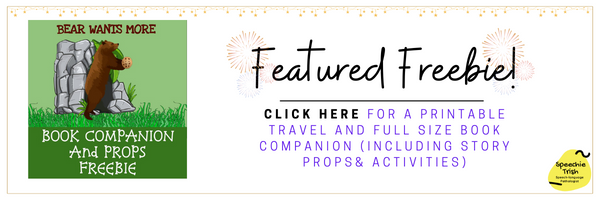13 Tips for Choosing Books for Preschoolers to Encourage Communication Skills
1) Creative engaging illustrations: pictures with bright colors and actions on the pages. Many times the simpler the illustrations, the more drawn the child is to examining the details of those simple pictures. Don’t Let the Pigeon Drive the Bus and The Snowy Day are great examples of classic children’s books with very simple illustrations. Although these books have colorful illustrations, the pictures are not too “busy” and allow children to focus on specific elements. The Pout Pout Fish, a book series by Deborah Diesen is another book that has engaging illustrations with detailed emotions in the sea creatures faces.
2) Select books that are relatively short and tell simple stories (or make a longer book short!). Because a book may have more text than a preschool child can sit for, doesn’t mean you need to read ALL the text. If a page maybe has 5 sentences, the adult can summarize the text for the child to keep their interest. A “picture walk” is a great way to preview a book or simply talk about what you and the child see in the pictures. The Three Pigs when read fully can be too long for some children, but can be easily shortened by the adult reading or summarizing the story but using repeated text throughout (“I will huff and puff” is an example of that repeated text).
3) Books that have limited or no text: Inside Outside by Lizi Boyd, Gravity by Jason Chin is about the advanced concept of gravity that can be simply understood. We talked about the word gravity and dropped items including the book. The kids had a blast! Carl’s Birthday by Alexandra Day is a series with limited text that contains pictures that tell the story of a dog’s birthday.
4) Books with Repetitive phrasing or pictures: Polar Bear Polar Bear What Do you Hear? And most books by Eric Carle have the quality of repetitive and memorable phrasing. Children really love this predictable text. 5 Little Monkeys and It’s Mine by Leo Lionni are also examples of books that contain repetitive scripts. Repetitive phrasing allows for practice of motor speech movements for children with Childhood Apraxia of Speech.
5) Rhyming, song or rhythm in the text is appealing to young children and invites them to join in with the story. Bear Wants More by Karma Wilson contains the repeated word “more” on each page. This can be used to teach specific sign language or vocabulary on augmentative and alternative communication devices. 5 Green and Speckled Frogs, and Dinosaurumpus by Toni Mitton also have captivating rhythms. Books where animals or people make certain sounds to imitate Moo, Baa, La La La are great for kids with limited verbal production.
6) Hidden pictures on pages entice a child’s curiosity. Dear Zoo is one of my favorites for this. Children open a flap to reveal a zoo animal that is not appropriate to take home. An easy way to make your own hidden picture book is to cover pictures with sticky notes. Children can make guesses as to what is underneath. Find the Duck and Find the Puppy by Felicity Brooks have pictures that children have to locate on each page. Hidden pictures are great for targeting answering “where” questions and preposition use (i.e “the duck is in the sink”).
7) Humorous books always encourage tons of language (think poop, body noises, silly things). Hey Bruce and other Mother Bruce Books by Ryan Higgins have children turning books upside down, wiggling and “pushing buttons” as part of the story. Duck In the Truck by Jez Alborough is a humorous story about a duck who gives his other animal friends some big problems.
8) Movable books/pages, tactile books and Books that Encourage Children’s Movement like Press Here by Herve Tullet where children follow directions to push, shake, and tilt the book to make things happen. Tip Tip Dig Dig by Emma Garcia is another book where children can imitate the vehicle's movements and move their bodies in similar ways.
9) Books that are of high interest to the child are important to consider. Little Mouse, Big Hungry Bear and the Red Ripe Strawberry by Don Wood is fun for children who love Bears or How Do Dinosaurs Say Goodnight? by Jane Yolen for kids who know all the dinosaur’s names. Sometimes books that are interesting to the child or character books that they have seen on videos or TV are great to explore with your child or student. If a book is motivating for the child, that book is valuable!
10) Award winning books (Caldecott or or other author/illustrator medals), and book by familiar children’s authors The Napping House by Audrey Wood, The GingerBread Baby by Jan Brett, The Very Busy Spider by Eric Carle are all Caldecott Winners for good reason!
11) Books that mimic real life events All Better by Henning Lohein about getting “boo boos” and making them feel better. Thank You Mr. Panda by Steve Antony about a Panda giving presents to all of his friends who are not grateful.
12) If you can extend the theme of a story with more activities it expands vocabulary and learning! As an example, with the book Inch by Inch by Leo Lionni, you can measure items in the room, your arm, a banana! Extending a book’s lesson, language or theme is a perfect way to extend that language to “real life”.
13) Be sure to think about books that are appropriate for your child’s fine motor skills: (Board books, larger pages, thicker paper and tiny hand held books). Although Pop up books are fun, they are very tempting to grab and pull the pop ups for little hands!




